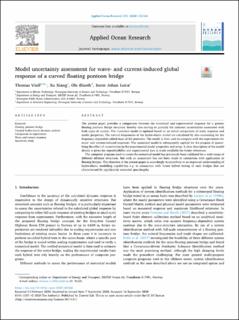| dc.contributor.author | Viuff, Thomas Hansen | |
| dc.contributor.author | Xiang, Xu | |
| dc.contributor.author | Øiseth, Ole Andre | |
| dc.contributor.author | Leira, Bernt Johan | |
| dc.date.accessioned | 2020-11-18T09:27:22Z | |
| dc.date.available | 2020-11-18T09:27:22Z | |
| dc.date.created | 2020-11-16T13:58:02Z | |
| dc.date.issued | 2020 | |
| dc.identifier.citation | Applied Ocean Research. 2020, 105, 1-12. | en_US |
| dc.identifier.issn | 0141-1187 | |
| dc.identifier.uri | https://hdl.handle.net/11250/2688395 | |
| dc.description.abstract | The present paper provides a comparison between the numerical and experimental response for a generic floating pontoon bridge structure, thereby also serving to quantify the inherent uncertainties associated with both types of models. The numerical model is updated based on an initial comparison of static response and modal properties. The natural frequencies of the hydro-elastic model are calculated by also accounting for the frequency-dependent added mass of the pontoons. The model is then used to compare with the experiments for wave- and current-induced responses. The numerical model is subsequently applied for the purpose of quantifying the effect of uncertainties in the experimental model properties and setup. A clear description of the model details is given for reproducibility and experimental data is made available for future references. The computer program used to create the numerical model has previously been validated for a wide range of different offshore structures, but such an assessment has not been made in connection with application to floating bridges. The objective of the present paper is accordingly to contribute to an improved understanding of hydro-elastic modelling capabilities e.g. in connection with future hybrid testing of such bridges that are characterised by significantly extended span-lengths. | en_US |
| dc.language.iso | eng | en_US |
| dc.publisher | Elsevier | en_US |
| dc.rights | Navngivelse 4.0 Internasjonal | * |
| dc.rights.uri | http://creativecommons.org/licenses/by/4.0/deed.no | * |
| dc.title | Model uncertainty assessment for wave- and current-induced global response of a curved floating pontoon bridge | en_US |
| dc.type | Peer reviewed | en_US |
| dc.type | Journal article | en_US |
| dc.description.version | publishedVersion | en_US |
| dc.source.pagenumber | 1-12 | en_US |
| dc.source.volume | 105: | en_US |
| dc.source.journal | Applied Ocean Research | en_US |
| dc.identifier.doi | 10.1016/j.apor.2020.102368 | |
| dc.identifier.cristin | 1848366 | |
| dc.description.localcode | This is an open access article distributed under the terms of the Creative Commons CC-BY license, which permits unrestricted use, distribution, and reproduction in any medium, provided the original work is properly cited. | en_US |
| dc.source.articlenumber | 102368 | en_US |
| cristin.ispublished | true | |
| cristin.fulltext | original | |
| cristin.qualitycode | 1 | |

